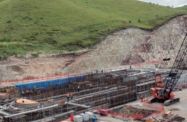The government in Papua New Guinea (PNG) has pledged to upgrade its infrastructure after years of underinvestment, a move which will also help plug the construction gap as the country’s mega project, the $19bn Liquefied Natural Gas (LNG) plant, is now completed and the related real-estate boom starts to cool.
National budget figures show that infrastructure spending will rise by more than a third in 2014 to PGK2.7bn ($1.01bn) from 2013, with more than PGK1bn ($406.5m) allocated for roads and PGK267m ($108.54m) for hospitals.
The country is also looking to renovate its airport as it prepares to host the Pacific Games in 2015 as well as the APEC summit in 2018. But improving the implementation capacity of public agencies to deliver the investment plans remains a core challenge, say analysts.
Market slowing
The real estate market in PNG has outperformed others in the region in terms of growth, bolstered by a decade of sustained foreign direct investment (FDI) into the hydrocarbons industry.
The LNG project had a large knock-on effect on the economy spurring growth in construction, real estate and other sectors, the World Bank noted in a report in 2011. The influx of wealth caused rents for upmarket units to double between 2008 and 2012, reaching PGK5500 ($2240) to PGK8000 ($3250) per week. As a result, developers in the high-end segment were garnering returns of 10-15% on building projects.
But the high-end expatriate residence market, flagged as an area of concern by the IMF back in 2011, has been oversaturated, leading to significant losses for development firms during the latter part of 2011 and 2012 as skyrocketing construction costs eroded both investor and buyer interest.
“Growth has been astounding in the past five years,” Garry Tunstall, chief executive of PNG’s largest superannuation fund, Nambawan Super, told Business Advantage PNG.
“That has really been about the PNG LNG project largely, and the infrastructure that’s required to support it, as well as other investors then seeing the opportunity to develop and build commercial and residential property. I think the country still will grow, but we have seen an easing of support for residential housing prices and rentals. We’ve seen commercial rents starting to ease off a bit.”
The Nambawan Super, along with PNG’s other big property investor, Nasfund, reported record profits in 2013. Nasfund’s net profit reached PGK335m ($136.18m), a 50% increase y-o-y, while Nambawan Super saw profits grow 17% to PGK410m ($166.67). Despite these results, Nasfund’s chairman warned that 2014 might not be as fruitful due to the winding down of the LNG construction phase and softer commodity prices.
Sources of opportunity
Since its 2013 budget, the government has recognised the need for a sustained investment in essential infrastructure and has pledged to implement major infrastructure projects currently under construction, as well as prioritise the efficient expenditure of the higher levels of provincial government funding.
Spending on transport, the highest-funded sector in the budget, will benefit two regions in particular – the Highlands-Momase region and the Papua region. At the same time, the World Bank has approved $126.5m in credit to rehabilitate hundreds of kilometres of roads in coastal provinces in PNG.
Lae port, the most important port in the country, is undergoing major expansion. The project will cost PGK730m ($296.75m) and help relieve congestion and improve efficiency, making it easier and cheaper to develop Lae itself, as well as the Highlands-Momase region. Work on the Yonki Dam, coming in at a cost of PGK205m ($83.33m), is expected to improve power supply in the region, especially for Lae and Madang.
Under the National Urbanisation Policy 2010-30, the country’s five largest cities have been earmarked for urban renewal and expansion. The plan has outlined upgrades to informal settlements, improvements to infrastructure, and preparation for a trebling of the urban population by 2030, from the current 1m to an estimated 3.5m.
Port Moresby (Jacksons) International Airport is undergoing a PGK100m ($40.65m) expansion, and expected to be completed in time for the Pacific games. There is also a plan to connect its current terminal buildings via a new building as well as the addition of a new flyover at the cost of PGK160m ($65.04m) to reduce congestion and cut travelling time to the airport.
At the same time, expectations of further developments in the LNG sector are attracting increasing amounts of capital to the PNG region. Northwest of Port Moresby, a gated 500-unit housing estate valued at PGK250m ($101.63m), called Edai Town, is being designed. Avenell Engineering Systems is planning to expand its 72-ha Ravuvu Business Park, which offers accommodation, office space, commercial and industrial lots and workshops, while Curtain Brother’s PNG Dockyard is set to open a new dry dock facility, valued at around PGK500m ($203.25m). Adjacent to the LNG plant, the government is looking to establish Konebada Petroleum Park to assist with the development of the local petrochemical industry.
However, new funding for the maintenance and operational activities related to new projects also needs to be earmarked said Aaron Batten, Asian Development Bank’s country economist, in his response to the 2014 budget.
“To maximise the development impact of its budget allocations, a larger focus will need to be placed on recruiting and training a much larger pool of skilled Papua New Guineans to be able prepare, deliver, and ultimately maintain these new assets,” he said.
Follow Oxford Business Group on Facebook, Google+ and Twitter for all the latest Economic News Updates. Or register to receive updates via email.

